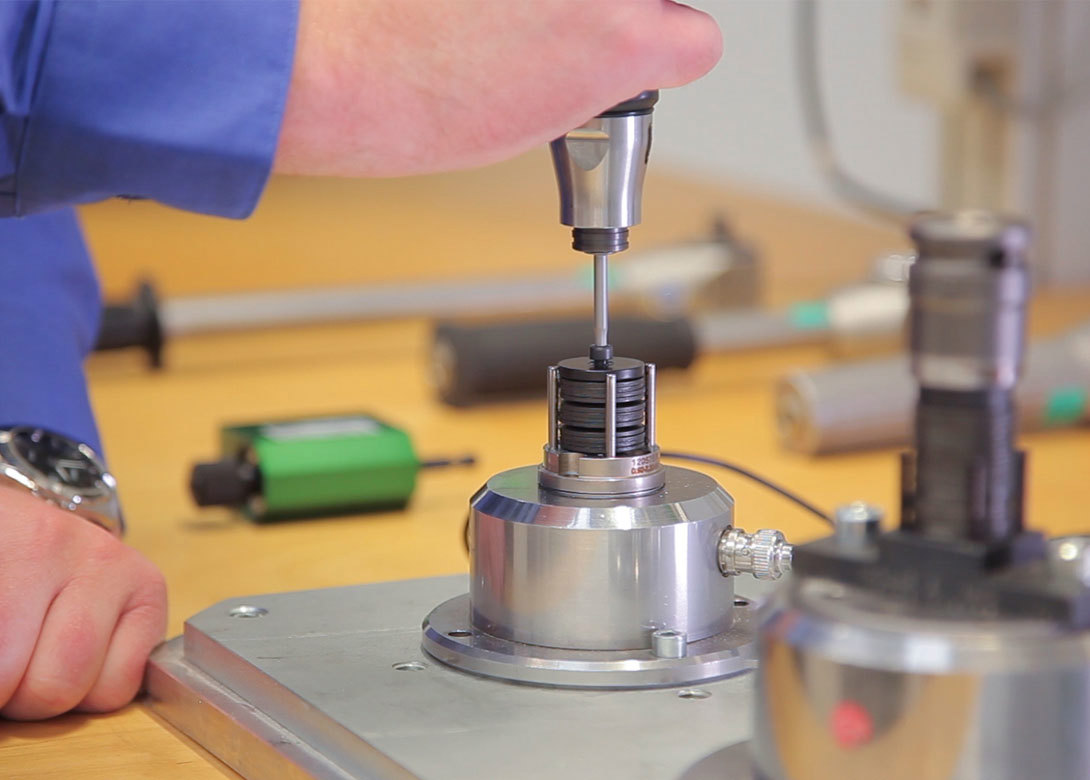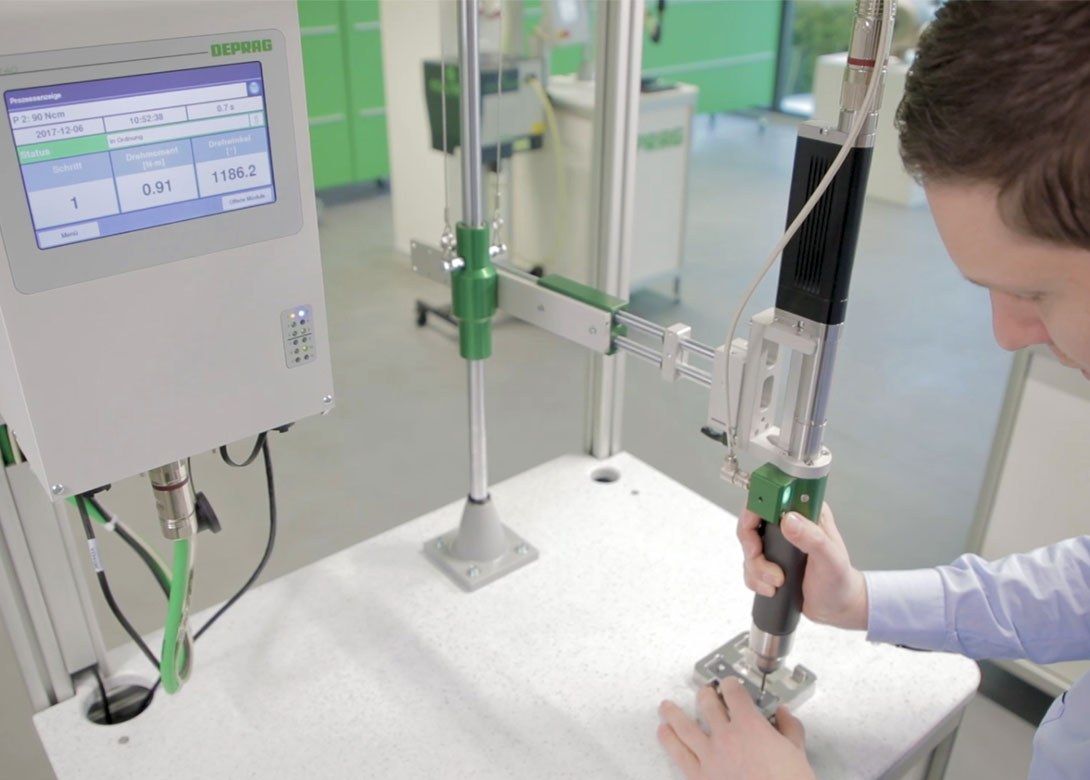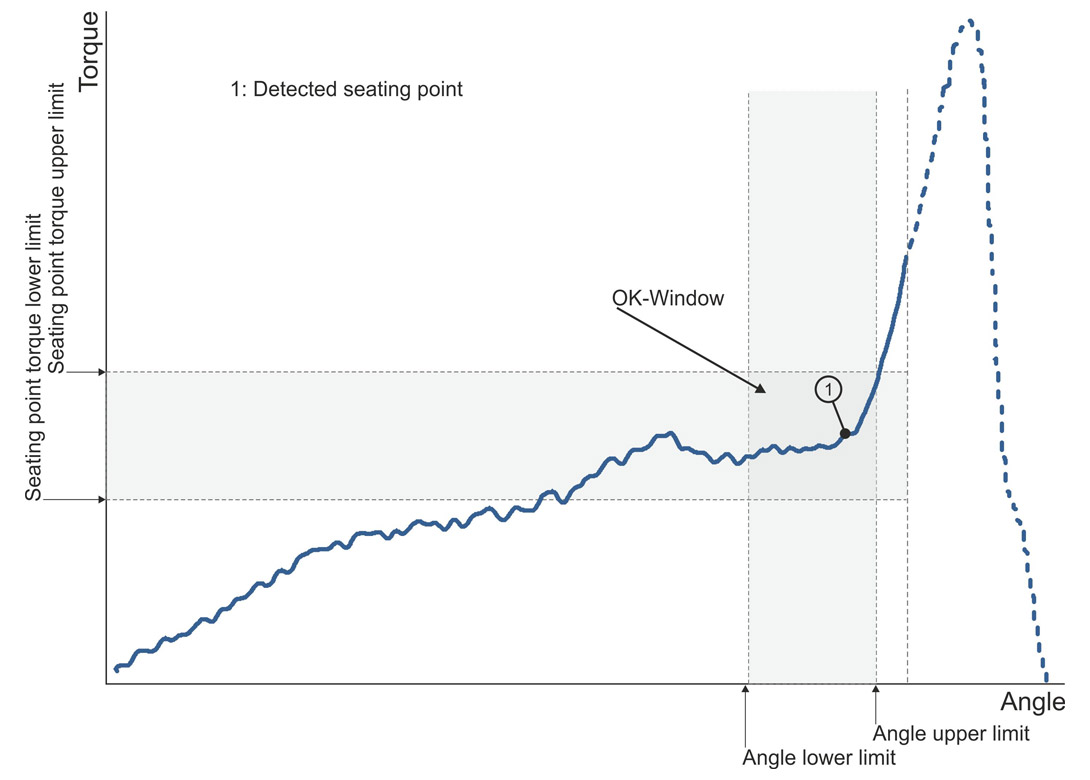
Screwdriving technology is the key to numerous assembly tasks. Screw fastenings are popular due to their resilience, part reusability and because of the option of undoing the connection at any time without damaging parts. Therefore, screws are the most frequently utilised standardised machine elements and are available in a wide range of designs.
The most important task for assembly fastening involves the application of a defined pre-load force. The pre-load force must be determined so that on one hand, the intended function can still be executed despite any applied operating force, and on the other hand, that the permissible load on the screw connection is not exceeded. It is the frequently unknown seating conditions of the screw connection which can be particularly problematic, as well as any assembly related fluctuations of the pre-load force.
Series screw assembly does not allow effective determination of the required preload force. Therefore, as an alternative, indirect measurements must be used to control the assembly process. Generally, this means the tightening torque of the screw assembly. Additionally, other experimentally determined parameters such as angle, screw-in time, friction etc, can act as reference variables for the assembly process. Furthermore, innovative procedures have been developed for the detection of the head seating point in order to improve the constancy of the pre-load force.
Torque controlled tightening procedure
Within screwdriving technology, torque is still used most frequently as the control parameter. The pre-load force resulting from the tightening torque is significantly influenced by the fluctuating coefficient of friction as well as the screwdriving device’s torque spread. In particular one must differentiate between head friction and thread friction. The sum of these fluctuating frictional conditions results in fluctuations of the pre-load force of up to 50% or more, despite high torque repeatability. This means that the screw connection always needs to be so over dimensioned that it is not overtightened if a deviation in the upper range occurs and that the required pre-load force is still applied in the case of a lower deviation. “Despite these drawbacks, torque-controlled tightening has emerged as the most popular tightening procedure. This is because technical realisation is relatively simple,” explains Daniel Guttenberger, screwdriving technology product manager at DEPRAG.

Angle controlled tightening procedure
During a so-called angle procedure, both the torque and angle of the screw connection are used as control parameters. In this case, it is the angle and not the torque which is used as the control parameter for the final tightening stage. This means that the screw is tightened to a specific threshold torque and tightening continues from there at a predetermined post-tension angle. The torque can be monitored as an additional control parameter.
Angle controlled shutoff can be used in both the elastic and plastic range of the screw. From the start of the angle assembly, tightening is carried out independent from friction. The complete pre-load force spread is therefore less than that of a purely torque controlled screwdriving procedure.
Friction dependent torque assembly
The friction value procedure is frequently used for testing processes. Here, the results of the friction value measurement are used to evaluate the quality of gears, threads or to determine minimum friction e.g. with self-locking threaded pins. Screw assembly to difference torque or angle independent from the friction torque is still an option.
Limit value controlled tightening procedure
In order to optimally utilise the material properties of the screw by reaching the plastic deformation range, a limit value controlled tightening procedure can be used. Here as well, torque and angle are recorded as control parameters. The declining pitch in the stress strain diagram when reaching the limit value is used as the shut-off criterium.
Looking at the stress strain diagram you can see that the increase is linear at first and levels out upon reaching the limit value. The axial force acts in proportion to the torque – the strain is proportional to the angle. Mathematically, the increase of a curve is defined as the reduction of the function. If the reduction of the torque falls to approximately 50% of the benchmark, the limit value is reached and the tightening process is ended. It is possible to overlay this process with angle and torque limits for additional safety.
This procedure reduces the drawbacks of fluctuating friction values or the restrictions of a specifically selected screw. The screws used can be dimensionally smaller in size due to the increased safety when reaching the necessary assembly pre-load force. The limit value control may only be used on highly accurate steel connections as the represented stress strain diagram is only valid in these cases. This procedure places high demands on the measurement and regulation technology of the screwdriving system if small or miniaturised screws are used.

Adaptive tightening procedure DEPRAG CFC Clamp Force Control
The reliable adaptive screwdriving procedure DEPRAG Clamp Force Control ensures a constant pre-load force despite fluctuating screw-in torque values. The complete screw assembly consists of the screwdriving template seating point detection and a screw assembly to difference torque or angle. The seating point detection is the key component. A mathematical evaluation function is formed based on a continuous assessment of the torque procedure. If the trend line calculated exceeds a specifically defined limit value, the seating point is considered to be detected – torque and angle readings at the time of seating are saved.
The calculation method combines two basic advantages: It is not influenced by coincidental fluctuations and increases during the torque procedure which do not arise from the actual seating point and the algorithm is universally valid so the user does not need to set any parameters specific to the evaluation.
The screwdriving procedure is used for applications where varying limiting conditions are present which can cause widely ranging torques. “Fluctuations arise for example due to changes in the screw or hole geometries, the structure of the component material, inconsistent surface qualities of the screw thread, spring-loaded elements or seating conditions,” explains Guttenberger.
The adaptive tightening procedure DEPRAG Clamp Force Control ensures uniform output for the subsequent end tightening through reliable detection of the seating point. Consequently, there is a significantly improved constancy in the pre-load force. Typical application examples include direct screw assemblies into plastic or metal.
“By taking the specific application and varying limiting conditions into account, a suitable tightening procedure can be determined for any screw joint, thereby improving the constancy of the pre-load force. A screw joint analysis can be decisive in determining the most reliable parameters. As well as recommending tightening procedures to our clients we are, of course, also able to competently recommend the best screwdriving tool for the job,” adds Guttenberger.
With 700 employees, represented in over 50 countries DEPRAG SCHULZ GMBH u. CO. is a well established global partner for the realisation of innovative concepts in screwdriving technology and automation. In addition to providing a full-service package in the fields of screwdriving technology, feeding technology, control and measurement technology, the machine builders also integrate their products in complex semi or fully automatic assembly systems.

Having spent a decade in the fastener industry experiencing every facet – from steel mills, fastener manufacturers, wholesalers, distributors, as well as machinery builders and plating + coating companies, Claire has developed an in-depth knowledge of all things fasteners.
Alongside visiting numerous companies, exhibitions and conferences around the world, Claire has also interviewed high profile figures – focusing on key topics impacting the sector and making sure readers stay up to date with the latest developments within the industry.





